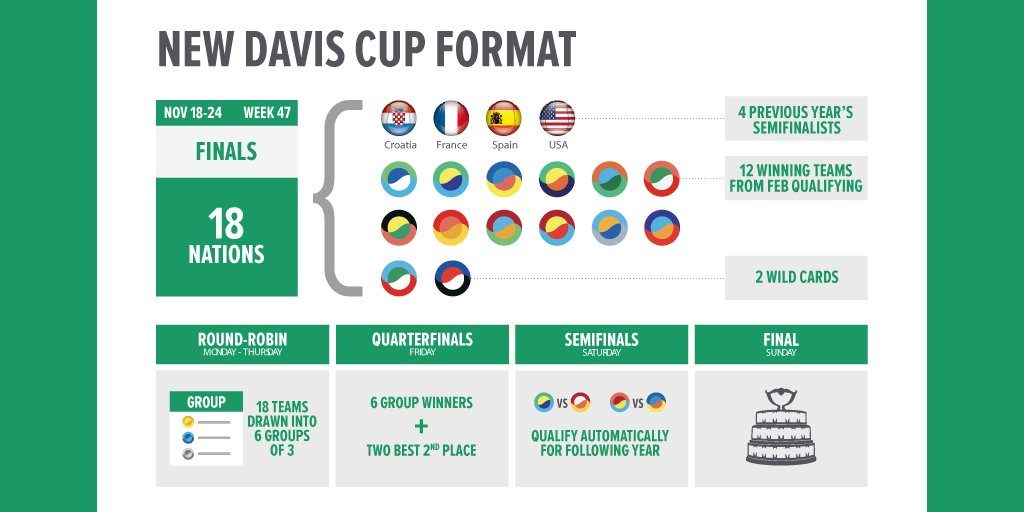Though I am a huge opponent of the Davis Cup reformations becoming active in 2019, I have to give in that the September 2018 Davis Cup weekend, mainly the World Group Playoff (qualification) matches, will offer a lot of interesting scenarios. Likely just a one-time effect, but add much more complexity to the last-time three-day best-of-five playoff round. Here is an overview about the road to 2019 and some possible scenarios.
Davis Cup 2019 – What’s planned?
First of all, a general rule change is that Davis Cup will generally be played best-of-three sets (no more best of five). Instead of having a head-to-head, the Davis Cup Finals will host an overall of 18 teams. The ITF plans a four day group match period with six groups of three teams each, which play a round-robin. The six group winners as well as the two best second-placed teams qualify for the quarter finals. Winning the Davis Cup will be become quite a hectic race then: all quarterfinals will be played on Friday, Saturday is semifinal day and Sunday the deciding final for the cup. One tie is reduced from five rubbers to three, two singles and a doubles match. Furthermore, the whole Davis Cup Finals tournament will be played in one location. Candidates for 2019 are Lille, France, and Madrid, Spain. I feel you need at least two courts to be able to handle this challenging schedule, but there is no information on that so far. 18 round-robin ties in four days means an average of this is 4.5 ties a day. The rules likely force you to play dead rubbers. In addition, all quarterfinals need to be held on Friday. Even with the reduced duration, one tie should easily be between four and six hours. Playing on two courts in parallel however means that half of the teams will not be broadcasted on TV.
Davis Cup 2019 Calendar
This change will also impact the Davis Cup calendar. First of all, the Davis Cup finals expand from one weekend in November to a full week, right after the ATP Finals (which leads to a certain doubt whether the top players will really go for this event. The first week of February will host the Davis Cup Finals Qualification only. Zonal ties will only be played in April and September. The teams losing the Qualification in February will compete in their zonal Group I in September.
All ties played with a choice of ground (i.e.: home and away), including the Qualification in February, will have five rubbers, four singles and a doubles match. They will be played best-of-three, though, so that the ties will just take two days instead of three in the past.
Davis Cup 2019 – How to qualify?
The four teams which will play the Davis Cup 2018 semifinals in September 2018 are automatically qualified for the Davis Cup Finals 2019. These are Croatia, Spain, USA and France.
Furthermore, the four quarterfinal looser teams are qualified and seeded for the February Qualification Round. These are Germany, Kazakhstan, Belgium and Italy. The seeding does not impact whether you play at home or away, but just means that you will likely have an easier opponent.
Added to these four teams, there will twenty additional teams in the Qualification Round. They are as follows:
- All World Group 2018 Playoff Winners (these will be seeded, regardless of their ranking)
- 12 additional teams, based on regional seedings:
- 6 Teams from Europe / Africa
- 3 Teams from Asia / Oceania
- 3 Teams from the Americas
After years of quite intransparent rankings, the ITF used the Davis Cup World Ranking for a couple of years now – so I guess they will do the same to pick the teams by regional preferences.
This leads to an overall of 28 teams somehow playing Davis Cup on World Group level in 2019. Two teams will receive a wildcard for the Finals to reach the total of 18 competing nations. I guess the teams will be wildcards will be selected amongst the 28 teams after the qualification. Some of the scenarios below illustrate, why the wildcards were a quite smart move by the ITF.
Finally, it is maybe worth to emphasize that Europe is dominating the list of nations, which are already qualified for the Qualifying Round or the Finals – this becomes quite important in the regional team rankings later: there are six European teams (no African), while USA (Americas) and Kazakhstan (Asia) are the only representatives of their regions.
Davis Cup World Group Playoff 2018 – Fixtures
The draw for the World Group Playoffs 2018, which has taken place in April 2018, looks as follows:
For the 2019 campaign, the most important feature of the draw is that in three cases, countries of the same zone will compete against each other:
- Argentina – Columbia (Americas)
- Switzerland – Sweden (Europe / Africa)
- Hungary – Czech Republic (Europe / Africa)
This means that – regardless how these teams will play – two European (I will skip Africa to make it shorter…) and one Americas team will qualify and be seeded in the 2019 Davis Cup Final Qualification in February.
Davis Cup 2019 – Current Ranking Table
Here is the ranking table as at before the World Group Playoffs 2018 (which means, there may be slight ranking changes due to the results). I skipped the points column, but therefore added some information:
- 2019: Fin if directly qualified for the Finals, Q if qualified and seeded for the Qualification in February
- 2018: PO if playing World Group Playoffs
- EUR / AMER / ASIA: Split zonal ranking
In the zonal ranking I excluded any country which is already qualified for the 2019 campaign. For example, France as World Ranking Leader is the best team in Europe, but Great Britain (#5) is the best European team which has not a fixed spot for 2019 already:
| Country | 2019 | 2018 | EUR | AMER | ASIA | |
|---|---|---|---|---|---|---|
| 1 | FRANCE | Fin | ||||
| 2 | ARGENTINA | PO | 1 | |||
| 3 | BELGIUM | Q | ||||
| 4 | CROATIA | Fin | ||||
| 5 | GREAT BRITAIN | PO | 1 | |||
| 6 | USA | Fin | ||||
| 7 | SPAIN | Fin | ||||
| 8 | AUSTRALIA | PO | 1 | |||
| 9 | SWITZERLAND | PO | 2 | |||
| 10 | SERBIA | PO | 3 | |||
| 11 | ITALY | Q | ||||
| 12 | GERMANY | Q | ||||
| 13 | KAZAKHSTAN | Q | ||||
| 14 | CANADA | PO | 2 | |||
| 15 | CZECH REPUBLIC | PO | 4 | |||
| 16 | JAPAN | PO | 2 | |||
| 17 | COLOMBIA | PO | 3 | |||
| 18 | NETHERLANDS | PO | 5 | |||
| 19 | HUNGARY | PO | 6 | |||
| 20 | INDIA | PO | 3 | |||
| 21 | SWEDEN | PO | 7 | |||
| 22 | AUSTRIA | PO | 8 | |||
| 23 | RUSSIA | 9 | ||||
| 24 | BRAZIL | 4 | ||||
| 25 | UZBEKISTAN | PO | 4 | |||
| 26 | CHILE | 5 | ||||
| 27 | BOSNIA/HERZEGOVINA | PO | 10 | |||
| 28 | CHINA, P.R. | 5 | ||||
| 29 | PORTUGAL | 11 | ||||
| 30 | ISRAEL | 12 | ||||
| 31 | DOMINICAN REPUBLIC | 6 | ||||
| 32 | BELARUS | 13 | ||||
| 33 | SLOVAKIA | 14 | ||||
| 34 | PAKISTAN | 6 | ||||
| 35 | UKRAINE | 15 |
Davis Cup 2019 – What does it mean for 2018?
The easiest example to explain why the table above (more precise: the updated one after the playoffs) is so important is maybe the situation in the Americas:
- As said above, three teams will qualify into the Davis Cup Finals Qualification as representatives of their regional zone.
- However, Argentina faces Columbia. The winner of this tie will qualify as a seeded team for the Qualification in February 2019 and thus does not take one of the unseeded zonal spots. Thus, the fourth ranked team will also enter to the Qualification Round in February 2019 and at least four teams will qualify. The fourth placed team would currently be Brazil, which is not even competing in the World Group Playoffs as they lost Argentina ealier in 2018.
- Accordingly, if Canada beats the Netherlands at home, they will not just take the seed, but book a ticket for the Chilean team (who are also done with 2018 and need to cheer for Canada on TV).
Due to similar arguments, Europe will at least have eight spots in February. There is no interzonal tie between Asian / Oceanian teams. As the point difference between the currently 3rd best Asian team, India, and the 4th best, Uzbekistan, is rather large, only an Uzbek upset in Great Britain would give those a chance to go to the Qualies 2019 by own effort – alternatively, they might take the spot if Australia beats Austria or Japan is victorious against Bosnia/Herzegovina. Vice versa, if both Asian teams and Australia fails, the Uzbek team will be the best team in the world ranking which does not qualify for the 2019 top-notch campaign.
Low-ranked Qualifyers?
In case of European dominance, i.e. all European teams win their interzonal ties, even Belarus as World Ranking #33 could play for a spot in Madrid or Lille in early 2019. It would mean that 16 / 24 teams will be European in February. Vice versa, with Australia, India and Japan winning their duels, #35 Pakistan will be the worst-possible ranked team in the 2019 Qualification Round. This also shows that you might need to level the regional distribution slightly by wildcards. Of course there is still the risk of diplomatic wildcard choice like inviting the best African team (which would be #42 ranked South Africa).
Going to the Finals 2019 as a Group II Team?
To make it more ridiculous: there are some scenarios, in which a designated Group II team will play Davis Cup Final Qualification in 2019: three European teams in the ranking list above, Portugal, Russia and Belarus (Russia and Belarus face each other) will in parallel have ties in the loosers round of Europe / Africa Group I .In case they loose these ties, they should either face Slovakia or South Africa to avoid relegation to Group II in October 2018. However, in case Europe is winning sufficient interzonal ties in the Playoffs, these countries could be boosted from loosers to World Group teams. There is insufficient information how Group I and II will in general compete in 2019. Depending on which teams qualify for the 2019 top-level campaign, there will be quite some movement necessary to have sufficient quantity of teams in some of the zonal groups. I could imagine you have to relegate or promote some teams after the February 2019 results to level these effects.
About being seeded in the Qualification 2019
Of course, one should always mention that you will call it preferable to be seeded to have a better chance to advance in February 2019 – but I feel, this one is really complex and funny. There are a lot of teams like India (which I will support in Serbia – Flyctory.com will cover this tie in collaboration with Indian Tennis Daily) who have a dead tie in regards of qualifying into the February knockouts. On the other hand, if there are some upsets in September, there could be some really tough unseeded opponents. In case Argentina does not beat Columbia, the world ranking #2 team will be an unseeded team in February – and an ugly-to-play opponent in the Qualfication Round.
Finally, I wish all of you two nice remaining Davis Cup weekends, the one in September and the finals, before the competition will be taken away all of its atmosphere. I have seen a lot of ties in the past – and tennis was simply the best in Davis Cup – even if you watched ties like Hungary vs. Egypt or Estonia vs. Slovenia (yeah, I did these two!).
Serbia vs. India Davis Cup – Coverage
In collaboration with the website Indian Tennis Daily, Flyctory is covering the Davis Cup tie between Serbia and India.
Here are the postings from Kraljevo, Serbia:
- Serbia vs. India – Preview and Draw Ceremony
- Serbia vs. India – Day 1
- Serbia vs. India – Day 2
- Serbia vs. India – Day 3
Serbia vs. India Davis Cup – Galleries
All pictures from Kraljevo are gathered in a dedicated gallery group. Here are the links to the individual galleries, split by Match:
- Serbia vs. India – Draw / Training / Preview Gallery
- Serbia vs. India – Singles #1: Djere – Ramanathan
- Serbia vs. India – Singles #2: Lajovic – Gunneswaran
- Serbia vs. India – Doubles: Milojevic / Petrovic – Bopanna / Myneni
- Serbia vs. India – Singles #3: Kristin – Balaji
At the end of 2018, I decided that this posting was my third best one during the 2nd half of 2018 in my “Most Important Postings”.
The Davis Cup coverage from Kraljevo is done in collaboration with
All graphics taken from ITF / Daviscup website and Twitter. Davis Cup logo by ITF.
Postings about Tennis
Here are all postings which are related to tennis on Flyctory.com























![Hall of Fame Open 2024 - MD R1: A. Goransson (SWE) / S. Verbeek (NED) - J. Paris (GBR) / R. Ramanathan (IND) 6-3 4-6 1-x [10-8]](https://flyctory.com/wp-content/uploads/2024/07/20240717_HoFOpen_GoransVerbeekParisRaman_BANNER-150x150.jpg)
![Hall of Fame Open 2024 - MD R1: Lemmins / Withrow (USA) - Chandrasekar / Kadhe (IND) 3-6 6-3 x-1[7-10]](https://flyctory.com/wp-content/uploads/2024/07/20240717_HoFOpen_LemmonWithrowChardrasKadhe_BANNER-150x150.jpg)
























































